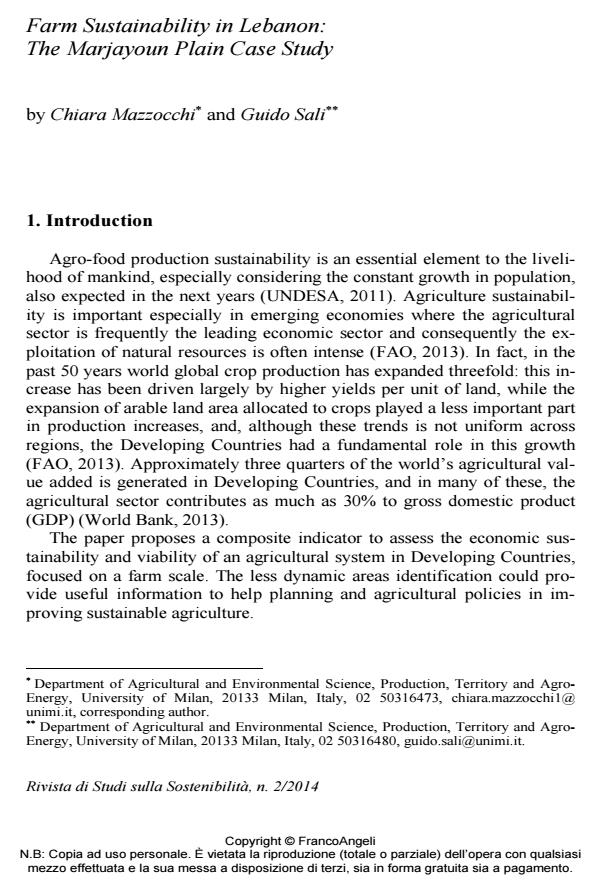Farm Sustainability in Lebanon: The Marjayoun Plain Case Study
Journal title RIVISTA DI STUDI SULLA SOSTENIBILITA'
Author/s Chiara Mazzocchi, Giudo Sali
Publishing Year 2014 Issue 2014/2
Language Italian Pages 14 P. 223-236 File size 229 KB
DOI 10.3280/RISS2014-002014
DOI is like a bar code for intellectual property: to have more infomation
click here
Below, you can see the article first page
If you want to buy this article in PDF format, you can do it, following the instructions to buy download credits

FrancoAngeli is member of Publishers International Linking Association, Inc (PILA), a not-for-profit association which run the CrossRef service enabling links to and from online scholarly content.
Agricultural system sustainability is influenced by different factors related to local agricultural structure. The impact of these factors on the farm functionality may provide an estimate, albeit crude, of the agricultural system dynamism and weaknesses. The paper proposes a tool useful for territory planning and agricultural policies programs to assess the viability of an agricultural system in Developing Countries, focused on a farm scale. The methodology is based on some agricultural variables affecting farm functionality and stability. The analysis was applied to the Marjayoun Plain, a Lebanese agricultural enclave. The results clearly disclose the existence of some vulnerability areas in the Plain but also some positive elements in terms of sustainability. The results are mapped by Geographical Information Systems tools.
La sostenibilita di un sistema agricolo e influenzata anche da diversi fattori connessi alla struttura dell’agricoltura locale. L’impatto di questi fattori sulla funzionalita dell’azienda agricola puo portare ad una stima, seppur grossolana, del dinamismo del sistema ma anche delle sue debolezze. Il paper propone uno strumento utile per la pianificazione territoriale e delle politiche agricole, per stimare la resilienza di un sistema agricolo nei paesi in Via di Sviluppo, a scala aziendale. La metodologia si basa su alcuni fattori endogeni all’azienda che possono influenzare la stabilita e la funzionalita del sistema. L’analisi e stata effettuata su un’enclave agricola libanese, la Piana di Marjayoun. I risultati mostrano l’esistenza di alcune aree vulnerabili nella Piana, ma anche altre in cui predominano elementi di forza del sistema agricolo. I risultati sono stati mappati tramite GIS.
Keywords: Sustainability, farm resilience, food security, Geographical Information System, PCA, Lebanon
Chiara Mazzocchi, Giudo Sali, Farm Sustainability in Lebanon: The Marjayoun Plain Case Study in "RIVISTA DI STUDI SULLA SOSTENIBILITA'" 2/2014, pp 223-236, DOI: 10.3280/RISS2014-002014